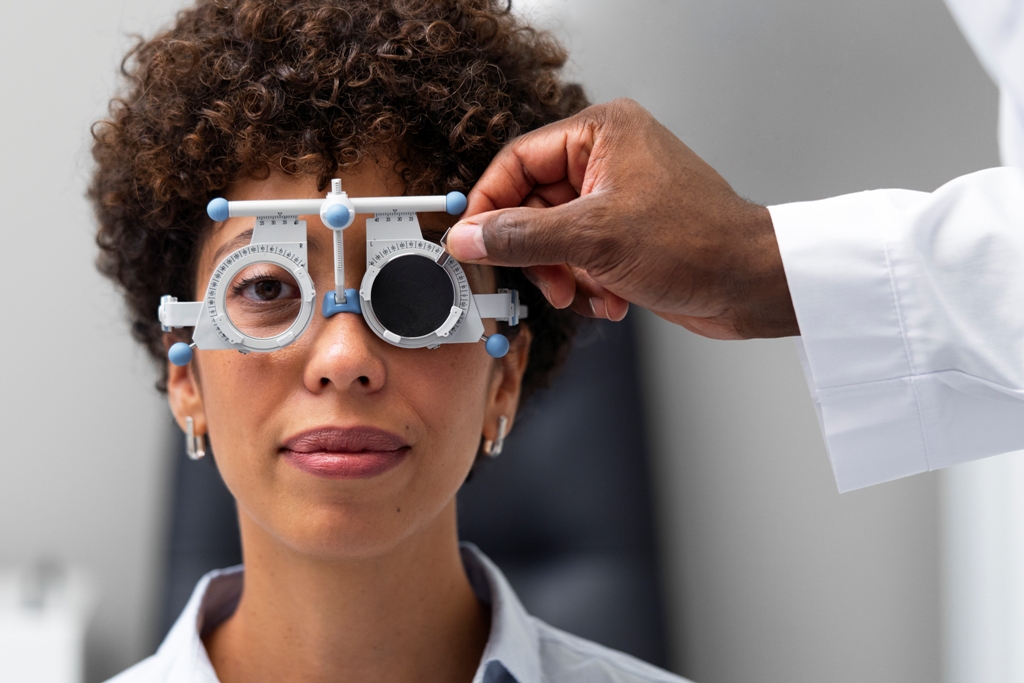Reviewed By: Dr. Priya Mathews, MD
The cornea—the clear, dome‑shaped surface at the front of the eye—does two jobs at once. It bends incoming light so images are in focus and shields delicate tissue from dust, germs, and ultraviolet rays. When disease, injury, or infection disturbs that transparent layer, vision can blur within hours or fade gradually as scarring spreads. Recognizing the earliest symptoms and getting prompt care can prevent many cases of long‑term vision loss.
How Corneal Tissue Can Break Down
Because the cornea has no blood vessels, it relies on tears and the inner eye’s fluid for oxygen and nutrients. Scratches usually heal quickly, but deeper damage or chronic conditions can warp their curve or cloud their surface, scattering light before it reaches the retina.
Conditions That Commonly Harm the Cornea
Keratitis (inflammation, which may be infectious)
Dirty contact lenses, swimming while wearing lenses, or a splash of contaminated water can let bacteria, fungi, or herpes viruses invade. Redness, aching, and sudden blur follow fast.
Keratoconus and related dystrophies
Inherited collagen weakness lets the cornea thin and bulge. Streetlights turn into starbursts, and glasses no longer sharpen vision. In Fuchs’ dystrophy, cells that pump fluid out of the cornea fail over time, creating morning haze that may clear by midday.
Corneal ulcer
An untreated infection or extended lens wear can carve a deep sore. Severe pain, watering, and a visible white spot demand same‑day therapy to prevent permanent scar tissue.
Dry‑eye‑related surface damage
Inadequate and/or unstable tear film leaves the epithelium rough. Gritty discomfort, fluctuating clarity, and burning often worsen after screen time.
Trauma and chemical exposure
A fingernail scratch, airborne debris, or household cleaner can scar the cornea within seconds, sometimes reopening days later if not treated correctly.
Symptoms That Call for Prompt Attention
- Persistent blur or ghost images
- Sharp, lingering eye pain
- Sensitivity to light indoors and out
- Redness that artificial tears don’t calm
- The sensation of grit or sand
- A visible haze or white spot on the surface
A single symptom that lasts more than a day deserves an exam; sudden pain or rapid vision change requires urgent care.
Diagnostic Steps Your Eye Doctor May Use
- Slit‑lamp exam – magnified view of each corneal layer.
- Fluorescein stain – harmless dye highlights scratches or ulcers.
- Corneal topography – maps curvature and thickness to spot early keratoconus.
- Cultures or PCR swabs – confirm bacterial, viral, or fungal sources when infection is suspected.
Precise diagnosis guides the right medication or procedure and avoids delays that cost clarity.
Treatment Options Matched to the Problem
- Targeted drops – antibiotics, antivirals, or antifungals clear infections; corticosteroids reduce inflammation once infection is under control.
- Rigid gas‑permeable or scleral lenses mask irregular surfaces in keratoconus, improving focus.
- Corneal cross‑linking – riboflavin and ultraviolet light strengthen collagen, halting keratoconus progression in most cases.
- Partial or full‑thickness corneal transplantation – replaces scarred or damaged tissue when the vision can no longer be improved with glasses or lenses.
Follow‑up frequency ranges from daily checks during acute infection to annual imaging for stable dystrophy.
Everyday Habits That Keep the Cornea Healthy
- Wash hands before handling contacts; replace or disinfect lenses exactly as directed.
- Wear impact‑rated sports goggles and chemical splash protection on the job.
- Choose sunglasses labelled 100 % UV to slow surface degeneration.
- Avoid eye rubbing; repeated pressure can thin or warp the cornea.
- Schedule yearly eye exams—sooner if you wear lenses, have dry eyes, or a family history of corneal disease.
Routine prevention often spares months of treatment and recovery.
When to Bypass Routine Scheduling
Seek immediate evaluation for:
- A burst of bright flashes or a sudden shower of new floaters
- A curtain‑like shadow moving through vision
- Severe pain after removing contact lenses
- Chemical splash, even if thoroughly rinsed
- A rapidly growing white spot on the corneal surface
Quick intervention preserves retinal and corneal tissue that delayed care could leave permanently damaged.
Moving Forward With Expert Guidance
Corneal disease rarely begins with dramatic symptoms; it often starts with a mild haze or new sensitivity to light. Addressing changes at that stage keeps treatment simple and recovery short. Specialists at the Center For Sight combine high‑resolution imaging with personalized care plans, from prescription drops to advanced graft techniques. Coordinating with primary‑care physicians ensures systemic conditions, such as autoimmune disorders or vitamin deficiencies, are managed alongside ocular therapy.
If you’ve noticed any warning signs, scheduling a comprehensive exam now safeguards the clear, comfortable vision needed for work, driving, and daily life.
Disclaimer: The information provided in this article is for general educational purposes only and should not be considered medical advice. Please consult a qualified ophthalmologist or eye care professional for personalized diagnosis and treatment options tailored to your specific needs.
About Center For Sight
Center For Sight provides ophthalmology, optometry, dermatology and cosmetic surgery services to patients in Southwest Florida. The practice offers patients convenient access to nationally renowned surgeons, highly-trained, compassionate staff members and cutting-edge technology. Center For Sight’s mission is to “bring clear vision to life” through trusting relationships and the unending pursuit of excellence in eye care. For additional information and locations, visit CenterForSight.net.
About Center For Sight Foundation
The Center For Sight Foundation is a donor-advised fund maintained and operated by the Gulf Coast Community Foundation, a section 501(c)(3) organization. The fund is composed of contributions made by individual donors. David W. Shoemaker, M.D., established the Center For Sight Foundation to support the annual Mission Cataract program, which restores vision at no cost for people living at the poverty level suffering vision loss due to cataracts. For more information, visit CFSFoundation.org.







